For a long time, Neptune was in the shadow of other planets in the solar system, occupying a modest eighth place. Astronomers and researchers preferred to study the large celestial bodies, directing their telescopes to the gas planets, the giants Jupiter and Saturn. Even more attention from the scientific community has received a modest Pluto, which was considered the last ninth planet of the solar system. Since its discovery, the planet Neptune and interesting facts about it, little interested in the scientific world, all the information about it were of a random nature.
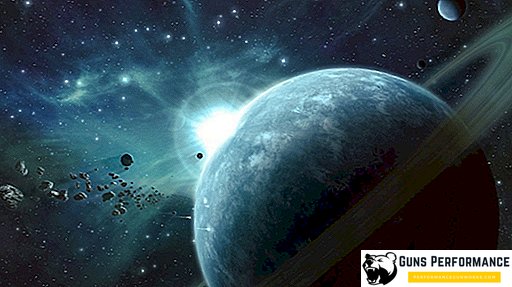
It seemed that after the decision of the Prague XXVI General Assembly of the International Astronomical Union on the recognition of Pluto as a dwarf planet, the fate of Neptune would change dramatically. However, despite significant changes in the composition of the solar system, Neptune is now truly on the outskirts of near space. From the moment the discovery of the planet Neptune was triumphant, the studies of the gas giant were limited. A similar picture is observed today, when no space agency considers the study of the eighth planet of the solar system as a priority.
Neptune Discovery History
Turning to the eighth planet of the solar system, it should be recognized that Neptune is far from being as huge as its counterparts - Jupiter, Saturn and Uranus. The planet is the fourth gas giant, as its size is inferior to all three. The diameter of the planet is only 49.24 thousand km, while Jupiter and Saturn have diameters of 142.9 thousand km and 120.5 thousand km, respectively. Uranus, although it loses to the first two, has a planetary disk size of 50 thousand km. and surpasses the fourth gas planet. But in terms of its weight, this planet is definitely among the top three. The mass of Neptune is 102 per 1024 kg, and it looks quite impressive. In addition to everything, this is the most massive object among other gas giants. Its density is 1,638 c / m3 and higher than that of the huge Jupiter, Saturn and Uranus.
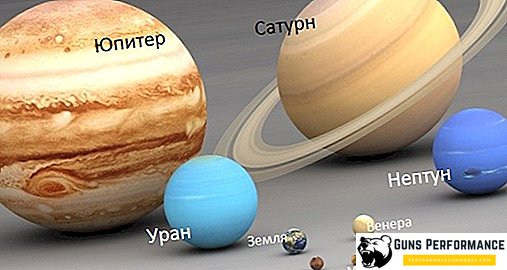
Possessing such impressive astrophysical parameters, the eighth planet was honored with an honorary title. In view of the blue color of its surface, the planet was given the name in honor of the ancient god of the seas, Neptune. However, this was preceded by a curious story of the discovery of the planet. For the first time in the history of astronomy, the planet was discovered by means of mathematical calculations and calculations, before it was seen through a telescope. Despite the fact that Galileo received the first information about the blue planet, its official discovery took place after almost 200 years. In the absence of accurate astronomical data of his observations, Galileo considered the new planet a distant star.

The planet appeared on the map of the Solar System as a result of resolving numerous disputes and disagreements that have long reigned among astronomers. As early as 1781, when the scientific world witnessed the discovery of Uranus, minor orbital vibrations of a new planet were noted. For a massive celestial body, which rotates in an elliptical orbit around the sun, such oscillations were uncharacteristic. Even then, it was suggested that beyond the orbit of a new planet in space, another large celestial object moves, which with its gravitational field affects the position of Uranus.
The riddle remained unsolved for the next 65 years, until the British astronomer John Kuch Adams provided for public review the data of his calculations, in which he proved the existence of another unknown planet in the solar orbit. In accordance with the calculations of the Frenchman Laverye, the planet of a large mass is located immediately beyond the orbit of Uranus. After two sources immediately confirmed the presence of the eighth planet in the solar system, astronomers around the world began to search for this celestial body in the night sky. The result of the search was not long in coming. Already in September 1846, a new planet was discovered by the German Johann Gall. If we talk about who discovered the planet, then nature itself intervened in the process. Information about the new planet was provided to man by science.
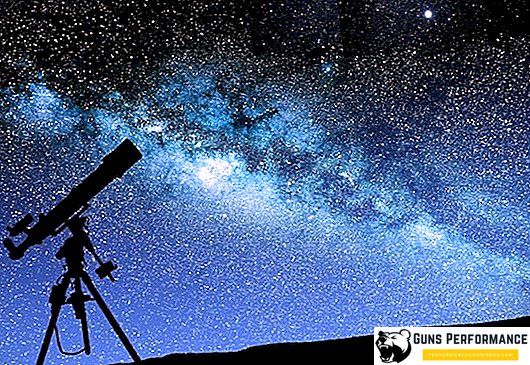
With the name of the newly discovered planet, there were at first some difficulties. Each of the astronomers who had a hand in the discovery of the planet tried to give it a name conforming to its own name. Only thanks to the efforts of the director of the Pulkovo Imperial Observatory Vasily Struve, the name Neptune was finally stuck to the blue planet.
What brought the discovery of the eighth planet science
Until 1989, mankind was content with visual observation of the blue giant, having only managed to calculate its main astrophysical parameters and calculate the true dimensions. As it turned out, Neptune is the most distant planet of the solar system, the distance from our star is 4.5 billion km. The sun shines in the Neptunian sky with a small star, the light of which reaches the surface of the planet in 9 hours. Earth is separated from the surface of Neptune 4.4 billion kilometers. It took 12 years for the Voyager-2 spacecraft to reach the orbit of the blue giant, and this was made possible by the successful gravitational maneuver that the station made in the vicinity of Jupiter and Saturn.
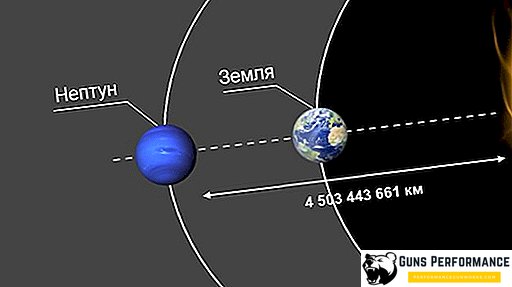
Neptune moves in a fairly regular orbit with a small eccentricity. The deviation between perihelion and aphelion is not more than 100 million km. The planet makes one revolution around our star in almost 165 Earth years. For reference, only in 2011 the planet made a complete revolution around the Sun since its discovery.
Discovered in 1930, Pluto, which until 2005 was considered to be the most distant planet of the solar system, at a certain period is closer to the Sun than distant Neptune. This is due to the fact that the Pluto orbit is very elongated.
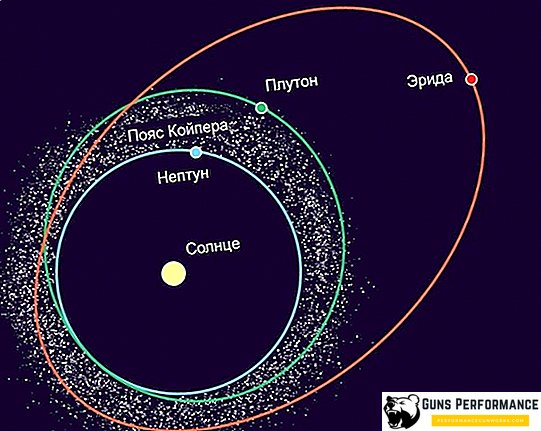
Neptune’s position in orbit is fairly stable. The angle of inclination of its axis is 28 ° and is almost identical to the angle of inclination of our planet. In this regard, there is a change of seasons on the blue planet, which due to the long orbital path lasts a long 40 years. The period of rotation of Neptune around its own axis is 16 hours. However, since there is no solid surface on Neptune, the rotational speed of its gaseous envelope at the poles and at the planet's equator is different.

Only at the end of the 20th century, people managed to get more accurate information about the planet Neptune. The space probe "Voyager-2" in 1989 overflew the blue giant and provided earthlings with images of Neptune from close range. After that, the most distant planet of the solar system revealed itself in a new light. The details of the astrophysical environs of Neptune have become known, as well as what its atmosphere consists of. Like all previous gas planets, it has several spans. Neptune’s biggest moon, Triton, was discovered with Voyager 2. There is also its own system of rings of the planet, which is true in scale below the aura of Saturn. The information received from the board of the automatic probe is currently the freshest and one of a kind, on the basis of which we got an idea of the composition of the atmosphere, of the conditions that prevail in this distant and cold world.
Today, the study of the eighth planet of our star system is conducted using the Hubble Space Telescope. On the basis of his photographs, an accurate portrait of Neptune was compiled, the composition of the atmosphere was determined, what it consists of, a number of features and characteristics of the blue giant were revealed.

Characteristic and brief description of the eighth planet
The specific color of the planet Neptune originated from the dense atmosphere of the planet. It is not possible to determine the exact composition of the blanket from the clouds covering the ice planet. However, thanks to the images obtained with the help of Hubble, it was possible to conduct spectral studies of the atmosphere of Neptune:
- the upper layers of the planet’s atmosphere are 80% hydrogen;
- the remaining 20% fall on a mixture of helium and methane, of which only 1% is present in the gas mixture.
It is the presence in the atmosphere of the planet of methane and some other, yet unknown component, which causes it to be the color of bright blue azure. Like other gas giants, the atmosphere of Neptune is divided into two regions - the troposphere and the stratosphere - each of which is characterized by its composition. In the zone of transition of the troposphere to the exosphere, the formation of clouds consisting of ammonia vapors and hydrogen sulfide occurs. Throughout the length of the atmosphere of Neptune, temperature parameters range from 200-240 degrees Celsius below zero. However, against this background, one feature of the atmosphere of Neptune is curious. This is an abnormally high temperature on one of the strata of the stratosphere, which reaches values of 750 K. This is probably due to the interaction of the lower layers of the atmosphere with the gravitational forces of the planet and the action of Neptune's magnetic field.

Despite the high density of the atmosphere of the eighth planet, its climatic activity is considered to be rather weak. In addition to strong hurricane winds blowing at a speed of 400 m / s, no other bright meteorological phenomena were noticed on the blue giant. Storms on a distant planet is a common occurrence, which is characteristic of all the planets of this group. The only controversial aspect that causes climatologists and astronomers has great doubts about the passivity of Neptune’s climate, the presence in its atmosphere of the Big and Small dark spots, the nature of which is similar to the nature of the large Red Spot on Jupiter.
The lower layers of the atmosphere smoothly pass into the layer of ammonia and methane ice. However, the presence of Neptune's quite impressive force of gravity, speaks in favor of the fact that the core of the planet may be solid. In support of this hypothesis, the high value of the acceleration of gravity is 11.75 m / s2. For comparison, on Earth, this value is 9.78 m / s2.

Theoretically, the internal structure of Neptune is as follows:
- the iron-stone core, which has a mass of 1.2 times the greater mass of our planet;
- the mantle of the planet, consisting of ammonia, water and methane hot ice, the temperature of which is 7000K;
- the lower and upper atmosphere of the planet, filled with vapors of hydrogen, helium and methane. The mass of the atmosphere of Neptune is 20% of the mass of the entire planet.
What is the real size of the inner layers of Neptune, it is difficult to say. This is probably a huge compressed gas ball, cold outside, and inside - heated to very high temperatures.
Triton - the largest satellite of Neptune
The space probe "Voyager-2" discovered a whole system of Neptune’s satellites, of which 14 were identified today. The largest object is a satellite, called Triton, whose mass is 99.5% of the mass of all other satellites of the eighth planet. Another curious. Triton is the only natural satellite of the Solar system, which rotates in the direction opposite to the direction of rotation of the mother planet. The idea is admitted that before Triton was similar to Pluto and was an object in the Kuiper belt, but then it was captured by a blue giant. After the Voyager-2 survey, it turned out that Triton, as well as the satellites of Jupiter and Saturn - Io and Titan - has its own atmosphere.
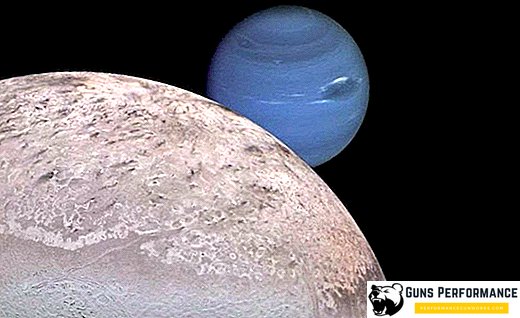
How this information will be useful for scientists, time will tell. In the meantime, the study of Neptune and its environs is extremely slow. According to preliminary calculations, the study of the border areas of our solar system will begin no earlier than 2030, when more advanced spacecraft will appear.












